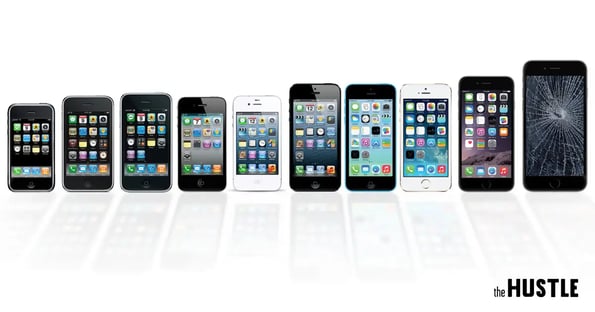Your favorite gadgets are going to die way sooner than you’d think. We all know they’ll slow down at some point, but what you might not realize is that their demise date has been carefully calculated by their engineers in order to make you to upgrade to the latest model. This strategy is called “planned obsolescence” and it’s about artificially limiting the lifetime of a product to force a new spend.

When I think about how executives came up with this, I imagine a big boardroom filled with waspy white men petting fluffy white cats, saying: “If our products fail on purpose, we can sell them the exact same thing again! Muhahahahah…”
But consumers are culpable as well.
This exists because our culture is obsessed with “new.” Corporations like Apple (the iPhone has a horrendously short life span) just do a good job of exploiting our own feelings.
Many people want to get a new phone every year, along with new clothes, new cars, new new new. That is their God-given right as Americans.
“No one can tell me how to spend my money.”
But people can’t tell you how to run your company, either.
Planned obsolescence is inevitable in an economy that thrives on new. This is especially apparent in the fashion industry. Even though last year’s clothes are still perfectly wearable, scores of people flock to malls for the latest “My Bae” shirt.
So if you’re a company and you choose to destroy your own products every few years, you can. Sometimes this makes sense.

For example…
New software means you need smarter processors. There’s a reason early-model iPhones don’t have Siri; they can’t handle it. So you buy a new phone which can cope with all the updates. When you know this, why would you put top-end processors in a phone with a short shelf life?
The same applies to batteries. Why install a five year battery inside a phone that will only be compatible with software for three years? Apple has proprietary five-point screws housing its processors and batteries so you can’t replace them yourself. Conveniently, the battery lasts around the time it takes for a new iPhone to come out, anyway.
Since Apple charges $79 for a replacement, you might as well just get the new phone, no?
It’s obvious that companies consciously engage in planned obsolescence – even if they don’t admit it. This is not a matter of goodness or evil, but of inevitability. Apple was the first company to make a successful smart phone, so they enjoyed a brief monopoly.
And monopolists have an incentive to provide goods with short shelf lives, according to economist Jeremy Bulow.
However, once other companies enter the market, incentives arrive for consumers to pick longer lasting products. And as Samsung, HTC, and Apple continue to compete, planned obsolescence will eventually decrease in prevalence.
But it’s also up to the consumers to resist the “next big thing.” We need to take responsibility for the situation we’re in.
Lessons from history regarding monopolies and incentives
The light bulb “cartel” of the early twentieth century fixed incandescent light bulb prices and purposefully shortened their lives, forcing consumers to buy more bulbs (according to an article on the Phoebus Cartel by Professor Dr. Krajewski).

The light bulb industry saw that it could increase its profits by reducing the lifetime of its product. Since it had a monopoly (at least the cartel acted as one), there was no opposition.
But today, there are many alternatives to incandescent light bulbs, such as CFLs and the newer LED bulbs. LEDs last for decades and use significantly less wattage (according to the IES and Energy Star, which both rate light bulbs independently) than CFLs and incandescent bulbs. Even lightbulbs, a product well-known for its planned obsolescence, are increasingly longer lasting thanks to the virtues of a competitive marketplace.
Thinking green(er)
We need to consider the effect this is having on the environment. Phone companies offer trade-in systems to recycle parts of their phone, but how many phones end up in desk drawers and eventually in landfills? Sure, Verizon has a no-landfill policy, but mobile electronic waste is still very common. Plus, how much do you trust Verizon?
Planned obsolescence is not inherently good or bad, but a product of the capitalist economy in which a monopoly thrives.
But with more competition we’ll hopefully see products fight to keep consumers. And one way to do this is by making long-lasting, durable products.
Take the wristwatch market. Watches are technologically superfluous but the industry made $7.2 billion in 2013. This market is all about durability. And fashion…
If consumers can forego the latest and greatest for sustainability, combined with the influence of a competitive marketplace, we will see a drop in planned obsolescence. Which means more money in our wallets and iPhones with a longer battery life. #winforall.